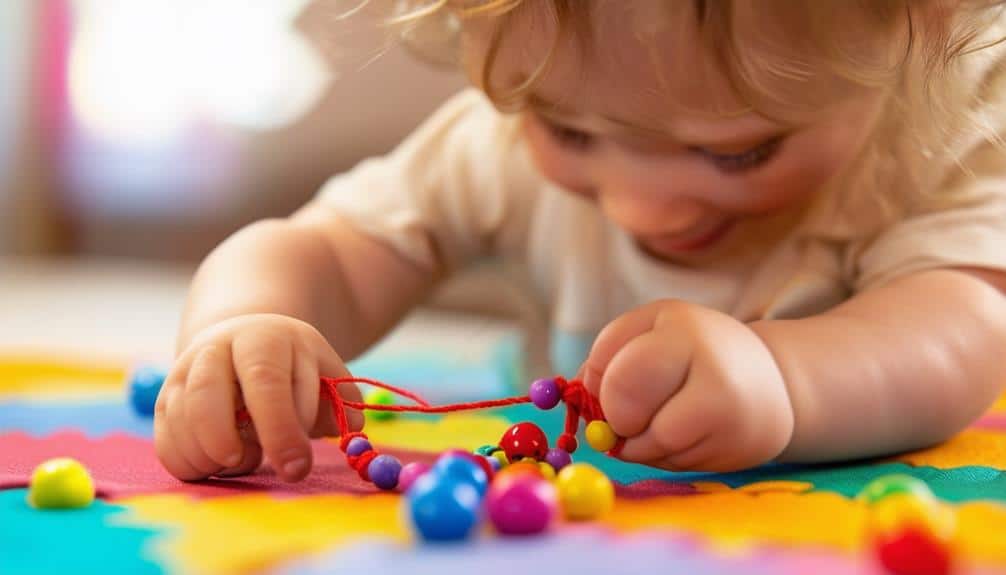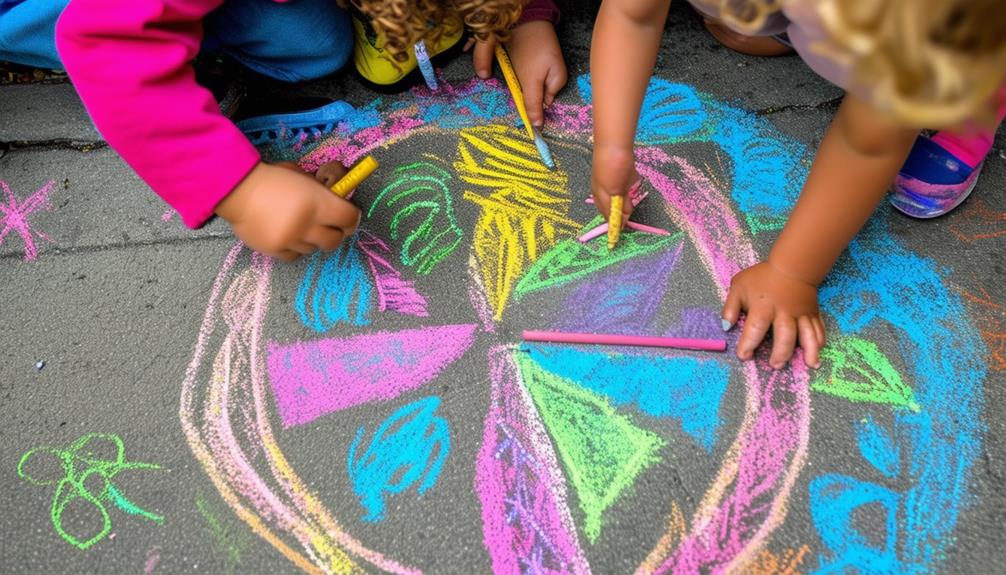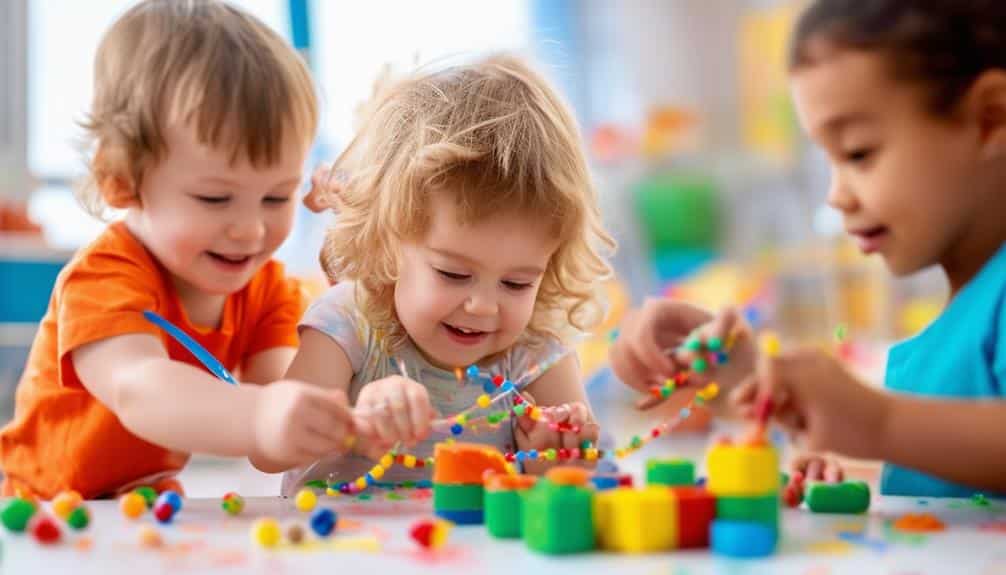Key Takeaways
- Engage children in sticker activities, enhancing pincer grasp and hand-eye coordination while making learning enjoyable.
- Encourage threading and lacing activities, improving hand-eye coordination, finger strength, and spatial awareness.
- Involve children in paper crafts to strengthen hand muscles, develop fine motor skills, and boost creativity.
- Implement coin activities to foster pincer grasp, strengthen hand and finger muscles, and enhance cognitive development.
- Incorporate putty activities that help develop hand and finger dexterity and strengthen small muscles in fingers.
Understanding Fine Motor Skills
Fine motor abilities, the intricate dance of small muscles in our hands and fingers, play a pivotal role in tasks that demand precision and finesse, such as writing, buttoning attire, or grasping minuscule objects. These skills are not merely about achieving tasks; they are a foundation for independence, fostering self-confidence in a child’s ability to navigate the world.
When discussing fine motor skills, it’s essential to understand that they are not innate abilities but developed ones. They require consistent practice and gradual refinement. Activities that demand accuracy, such as tying shoelaces or using utensils, offer ample opportunities for such development.
Mastering fine motor skills isn’t just about physical prowess; it’s closely tied to a child’s academic success and cognitive growth. Strong motor skills can enhance a child’s hand-eye coordination, finger strength, and overall manual agility, all of which are critical for later learning tasks like writing and drawing.
Understanding the importance of fine motor skills development is critical to serving others, especially young children. By fostering these skills, we are not merely teaching children to manipulate objects but equipping them with the tools for lifelong learning and independence.
Sticker Activities for Coordination
Sticker activities can enhance young children’s fine motor skills, especially their pincer grasp and visual motor coordination. Placing and peeling stickers not only cultivates their hand-eye coordination but also turns learning into an enjoyable experience. We will explore various sticker activities and their role in promoting these essential developmental skills as we proceed.
Boosting Pincer Grasp
While it might seem simple, engaging young children in sticker undertakings can effectively boost their pincer grasp, enhance visual motor coordination, and improve their fine motor skills. Peeling stickers off their hands or clothing subtly trains their fingers to perform the pincer grasp, a critical hand movement that promotes greater hand-eye coordination.
Sticker projects are more than just fun distractions; they are beneficial tools for enhancing children’s fine motor skills. For instance, drawing open circles on paper for sticker placement prompts children to use their fingers precisely. It’s a fun and interactive challenge that stimulates their cognitive and physical development.
The beauty of sticker undertakings lies in their versatility. They can be tailored to a child’s interests, making learning rewarding and engaging. They can be as simple as putting stickers on a chart to mark good behavior or more complex, like creating a story using sticker graphics. In doing so, children strengthen their hand muscles, foster creativity, and improve their coordination skills effectively.
Enhancing Visual Motor Skills
Given their myriad advantages, it’s essential to ponder the role of sticker activities in enhancing visual motor skills and coordination among young children. Although simple and fun, sticker activities can significantly develop vital abilities such as fine motor skills and hand-eye coordination.
Peeling stickers off hands or clothing strengthens hand muscles and fine motor skills. It might seem like a trivial task, but it is engaging and challenging for a child, enhancing finger skill and precision.
Placing stickers on hands or in open circles on paper promotes hand-eye coordination. It encourages the child to use their sight and hands coordinated, improving their visual-motor skills.
| Activity | Benefits |
|---|---|
| Peeling Stickers | Strengthens hand muscles and enhances fine motor skills |
| Placing Stickers | Promotes hand-eye coordination and visual motor skills |
Sticker activities are an enjoyable and effective way to assist children in improving their visual motor skills and hand-eye coordination. As educators and caregivers, we must provide them opportunities to develop these skills engagingly and playfully.
Stringing Activities: Fun and Development

Threading activities can offer an impressive array of benefits. They stimulate fun and creativity and effectively hone hand-eye coordination and fine motor skills in young children. Threading Cheerios or beads onto a piece of string or pipe cleaner boosts their pincer grasp, an essential fine motor skill that involves using the thumb and index finger to grasp small objects.
Threading activities promote bilateral coordination, as children must use both hands to thread objects successfully. This is especially useful in preparing them for tasks such as tying shoelaces or using cutlery.
The beauty of threading activities is that they can quickly adapt to suit different skill levels and interests. For beginners, you can start with larger objects and gradually introduce smaller, more challenging ones as their skills improve. Other materials like pipe cleaners or yarn can add variety and stimulate children’s creativity.
Paper Crafts for Hand Strength
Undoubtedly, paper crafts provide an excellent opportunity to strengthen hand muscles and develop fine motor skills in young ones. Simple activities like tearing or crumpling paper can notably enhance a child’s hand strength. This enjoyable and interactive delicate motor task boosts the bimanual tripod grasp and nurtures a child’s creativity.
Tearing paper for mosaic crafts is another efficient method for building hand and finger strength. It enables children to participate in an artistic experience while enhancing skill and imagination. These tasks can be customized to match each youngster’s unique capabilities and preferences, ensuring inclusivity and adaptability.
Furthermore, paper activities such as cutting and gluing can greatly enhance fine motor control and spatial awareness in young kids. Cutting along designated lines with scissors is a challenging yet fulfilling activity that improves hand strength and fine motor skills. On the contrary, using adhesive in paper projects helps children attach items accurately, further advancing fine motor skills development.
Coin Activities: Grasp and Strength

Exploring coin activities offers a practical and enjoyable way to foster the development of pincer grasp and visual motor coordination in young children. These activities, such as sorting and stacking coins, increase the challenge and improve hand and finger strength.
Consider the following coin activities to incorporate into your child’s play routine:
| Activity | Benefits |
|---|---|
| Sorting Coins | It enhances pincer grasp, promotes hand-eye coordination, and supports cognitive development as children identify different coins. |
| Stacking Coins | Strengthens hand and finger muscles, improves pincer grasp, and boosts concentration and patience. |
| Placing Coins in a Piggy Bank | Encourages precise manipulation, strengthens hand-eye coordination, and promotes understanding of value and saving. |
Coin activities are not only engaging, but they also promote fine motor skills and hand dexterity. By nature, coins require precise manipulation, enhancing hand strength and supporting early motor skill development. Remember, the goal is to make learning fun and engaging for your child. Your child’s fine motor skills can develop significantly with patience, consistency, and a handful of coins.
Clothespin Activities for Dexterity
Moving on from coin activities, another fun and effective means to enhance your child’s fine motor skills and hand dexterity is through clothespin undertakings. These simple but potent exercises help little hands develop strength and precision, fundamental skills that will support them in many aspects of their lives.
Clothespin undertakings can be as straightforward as attaching clothespins to the edges of a sturdy board book. This promotes fine motor skills and sparks creativity in your child as they devise different patterns and arrangements. It also introduces them to the concept of cause and effect as they handle the clothespin, providing a multifaceted learning opportunity.
Moreover, clothespin exercises can facilitate body awareness and foster independent dressing skills. You can encourage this by having your child use clothespins on their clothing, which also cultivates hand strength and precision grasp. These undertakings offer a hands-on, engaging way to improve fine motor skills and talent.
Creative Sidewalk Chalk Activities

In addition to clothespin activities, creative sidewalk chalk exercises offer another excellent avenue for enhancing your child’s fine motor skills and hand-eye coordination. These activities promote creativity and engage children in physical movement, making learning an active and enjoyable process.
Drawing with sidewalk chalk is a superb strategy for fine motor skills development, as it reinforces the coordination between the hands and eyes. Activities like hopscotch and chalk tracing lines enhance gross and fine motor skills. The physicality of these games also introduces an element of fun, which can motivate children to engage more frequently and enthusiastically.
Sidewalk chalk activities are not limited to games; they can also be educational. Children can practice letter formation, shapes, and numbers, enhancing their motor skills while learning essential academic concepts. This combination of play and education encourages imaginative play and social interaction while building vital motor skills. Therefore, sidewalk chalk activities are an effective and enjoyable means of promoting your child’s development, making them a worthwhile consideration for any parent or caregiver.
Threading and Lacing Fun
Threading and lacing activities are enjoyable and essential for developing fine motor skills in young children. Selecting appropriate materials and understanding how to progress the activities can enhance the benefits of these tasks. Let’s explore how these creative exercises boost hand-eye coordination, finger strength, and spatial awareness and how we can optimize these activities for maximum skill development.
Choosing Appropriate Materials
Selecting fitting materials for threading and lacing activities, such as beads, Cheerios, or large buttons, can significantly enhance a child’s hand-eye coordination and precision while engaging the small muscles in their hands and fingers. This practical and fun approach to skill development promotes dexterity and encourages bilateral coordination as children use both hands in an organized manner.
When choosing materials, consider the following:
- Size: Larger objects are more accessible for beginners to handle. You can introduce smaller items to increase the challenge as their skills improve.
- Texture: Varied textures can provide valuable sensory feedback. Smooth beads, roughened buttons, or soft yarns can all contribute to sensory development.
- Skill level: Tailor the materials to the child’s skill level. Start with simple, easy-to-handle items and gradually introduce more complex shapes or materials.
Activity Progression Tips
Moving forward with the selected materials, following a gradual progression in the threading and lacing activities that can effectively enhance a child’s fine motor skills is important. It’s essential to start with larger beads or objects. This initial stage of fine motor skills activities helps children build confidence and develop their grasp skills. You can introduce smaller beads or objects as their hand and finger coordination improves.
Encouraging hand-eye coordination and bilateral integration through threading and lacing is a pivotal aspect of fine motor skill development. These activities not only develop muscle memory but also enhance finger dexterity.
Use colorful beads or objects to make the activities more engaging and stimulating. This will not only keep their interest piqued but will also assist in their color recognition skills.
| Stage | Activity |
|---|---|
| 1 | Threading large beads |
| 2 | Threading smaller beads |
| 3 | Lacing beads |
Benefits of Threading Activities
Delving into the myriad benefits of threading activities, it becomes evident that these fun and engaging tasks considerably bolster a child’s hand-eye coordination and fine motor skills. Building on these foundational abilities, children can navigate their world more adeptly, performing tasks from buttoning shirts to handwriting with improved ease and precision.
- Development of Pincer Grasp and Finger Strength: Through the repetitive motion of threading, children build their finger strength, essential for tasks such as gripping a pencil or using utensils.
- Enhancement of Bilateral Coordination: Threading activities require children to use both hands simultaneously in a coordinated manner, improving their bilateral coordination. This skill is crucial for tasks like tying shoes or playing musical instruments.
- Boost in Concentration and Focus: Threading’s intricate nature demands a high focus and concentration from children, helping them develop these essential cognitive skills.
Putty Activities for Finger Strength
Promoting hand and finger dexterity and putty activities are excellent methods for developing finger strength in young children. Squeezing and manipulating the putty effectively strengthens the fingers’ small muscles. These activities are more than just fun and games; they are an essential tool for developing fine motor skills.
The malleability of putty allows children to engage their fingers in various ways. For instance, rolling putty into balls, creating shapes, and hiding small objects can provide fun challenges that enhance their fine motor skills and precision. The repeated actions required in these activities encourage using different finger muscles, improving strength and coordination.
Incorporating putty activities into the child’s daily routine can yield significant benefits. They serve as an enjoyable pastime and lay the foundation for hand and finger dexterity for performing various tasks such as buttoning a shirt, holding a pencil, or tying shoelaces.
Pick Up Sticks for Isolation
The game of Pick Up Sticks is not just a classic pastime but also a valuable tool for promoting finger isolation, a critical component of fine motor skills. This game, which requires precision and control, enhances hand-eye coordination and aids in developing concentration skills. We will further explore these benefits, discuss engaging play techniques, and understand how this seemingly simple game can significantly contribute to a child’s motor skill development.
Understanding Finger Isolation
Finger isolation—the capacity to move one finger independently of the others—is an essential ability in fine motor skills that can be effectively developed through games like Pick Up Sticks. This simple yet engaging game encourages children to pick up sticks one at a time without disturbing the others, thereby promoting fine motor control and precision.
Understanding finger isolation is essential for various reasons:
- It aids in tasks requiring fine motor control, such as writing, buttoning a shirt, or grasping small objects.
- It enhances hand-eye coordination, an essential skill for academic and physical activities.
- It fosters independence and confidence in children as they realize they can perform tasks independently.
Engaging children in games like Pick Up Sticks provides them with fun, entertainment, and skills that will serve them well throughout their lives. As caregivers and educators, our role is to provide opportunities for children to develop these skills in a nurturing and supportive environment, understanding that each child’s journey to mastering finger isolation and fine motor control is unique.
Benefits of Stick Games
With a rich history spanning generations, stick games like Pick Up Sticks offer many benefits, including the enhancement of finger isolation, fine motor control, and hand-eye coordination. This fun and engaging activity promotes motor skills and encourages precision and attention to detail.
The key to Pick Up Sticks lies in its requirement for focused attention. Players must carefully isolate and pick up specific sticks without disturbing the rest, which naturally develops fine motor skills and accuracy. Additionally, the challenge of this game encourages patience and persistence, essential qualities for the overall growth of young children.
Furthermore, the hand-eye coordination required to play this game successfully enhances children’s visual motor skills – a crucial component of many everyday tasks. The game’s simplicity allows for easy integration into playtime, and its universal appeal ensures it remains a favorite among children of all ages.
Engaging Play Techniques
Often overlooked, the game of Pick Up Sticks is an engaging method for enhancing finger isolation and fine motor skills in young children. This playful activity encourages focus and hand-eye coordination, promoting precision in grasping objects.
- Focus and Concentration: Picking up a single stick from a pile without disturbing the others requires intense concentration and focus. This mental engagement can help children develop the ability to concentrate on the tasks at hand.
- Hand-Eye Coordination and Precision: Carefully isolating and picking up each stick requires precise control over the fingers and hands. This playful challenge helps to improve both hand-eye coordination and precision in movement.
- Strategic Thinking and Spatial Awareness: Deciding which stick to pick up first and how to do so without disturbing the rest of the pile can foster strategic thinking. Moreover, understanding the spatial relationship between the sticks can enhance a child’s spatial awareness.
Bubble Activities: Dexterity and Fun

Blowing bubbles is not just a delightful pastime for children; it also dramatically improves finger dexterity and hand-eye coordination. This seemingly simple and fun activity provides a valuable platform for children to hone these essential skills engagingly and enjoyably.
Bubble activities help children refine their motor skills in a playful and tactile environment. When children track and attempt to grab the bubbles, they unknowingly work on their visual motor skills, enhancing their ability to synchronize their hand movements with their visual focus. Popping the bubbles with their fingers allows them to practice precision and control, strengthening their finger dexterity and improving their fine motor skills.
Incorporating bubble activities into regular playtime also promotes sensory exploration. The soft, ephemeral nature of bubbles can be a captivating sensory experience for children, stimulating their curiosity and encouraging them to interact with their surroundings.
In essence, bubble activities are fun and serve as a practical tool for refining motor skills and promoting sensory development in young children. By fostering these skills early on, we equip our children with the necessary foundation for a successful future.
Sorting Activities for Precision
Sorting activities, such as Coin Sorting Skills and Bead Classification Exercises, are powerful tools for fostering precision in young children’s fine motor skills. These activities require children to categorize items based on specific attributes, enhance attention to detail and accuracy, and stimulate cognitive development. Additionally, they provide an enjoyable and interactive way to boost hand-eye coordination, visual perception, problem-solving abilities, and organizational skills.
Coin Sorting Skills
One highly efficient way to enhance the precision of hand and finger movements in young children is through coin-sorting activities. These activities are designed to develop fine motor skills through practical, engaging tasks. When children sort coins by size, color, or denomination, they learn about money and enhance their visual discrimination and hand-eye coordination.
- Pincer Grasp: Coin sorting activities are excellent for developing the pincer grasp, an essential fine motor skill. As children pick up and move each coin, they naturally utilize this grasp, strengthening their fingers and enhancing dexterity.
- Concentration and Organization: Coin sorting requires focus and attention to detail, promoting concentration. Simultaneously, it encourages organization skills as children must correctly categorize the coins.
- Visual Discrimination and Hand-eye Coordination: Coin sorting helps improve a child’s ability to discern differences and similarities, an essential skill in visual discrimination. It also enhances hand-eye coordination as children must accurately place each coin in its designated place.
Bead Classification Exercise
Harnessing the playful nature of young children, bead classification exercises provide an engaging avenue for enhancing precision and refining fine motor skills development. This acceptable motor skill activity involves children sorting beads by color, shape, or size. It’s a fun game and a valuable tool that cultivates attention to detail and hand-eye coordination.
Children can practice sorting beads into different compartments, cups, or containers, encouraging them to use their pincer grasp and hand strength. This hands-on approach facilitates the development of these critical skills through tactile and visual stimulation. Each bead picked up and sorted improves precision and builds hand strength, an essential aspect of fine motor skill development.
Bead classification exercises offer an enjoyable, educational task and a platform for children to learn and grow. By incorporating such playful tasks into their routine, children can enhance their fine motor abilities and hand-eye coordination enjoyably and engagingly. As service providers, we aim to provide children with enriching activities that allow them to develop essential skills while having fun. Bead classification exercises achieve this goal beautifully, nurturing children’s skill development through playful engagement.
Maze Activities: Problem-Solving Skills

While seemingly simple, maze activities play a pivotal role in aiding children to develop robust problem-solving skills by challenging them to maneuver through intricate paths. These fun and interactive games are not just a source of entertainment but an effective method of honing fine motor skills.
- Hand-eye coordination: Maze activities require children to use their eyes to guide their hands, improving their coordination. As they trace the maze lines, they develop precise control over their hand movements.
- Spatial awareness: Navigating through a maze demands a sense of space and direction. This spatial reasoning helps children understand their position about obstacles, fostering a keen sense of direction.
- Concentration: The challenge of solving a maze holds children’s attention, teaching them to focus. This concentration, subsequently, facilitates the development of their fine motor skills.
Incorporating maze activities into a child’s routine can thus have multiple benefits. They provide an enjoyable medium for children to enhance their problem-solving skills while refining their fine motor skills. Maze activities perfectly blend fun and learning, promoting overall child development.
Perler Bead Activities for Coordination
Perler bead activities involve placing tiny plastic beads on a pegboard to form intricate designs and patterns. These hands-on activities can significantly enhance a child’s coordination and fine motor skills. They also promote creativity and refine the precision of manipulating small objects.
Perler bead activities foster hand-eye coordination, an essential skill that aids in overall development. By picking up and placing tiny plastic beads on a pegboard, children learn to control their hand movements in line with what they see. Such exercises can significantly improve their academic abilities, particularly in writing or drawing tasks.
The beauty of Perler bead activities is that they are suitable for children of various ages. Younger children can start with simpler patterns, gradually moving onto more complex designs as their skills progress. This offers them a sense of accomplishment, encouraging perseverance in developing fine motor skills.
Frequently Asked Questions
How can I give my child a motor skills boost at home?
You can boost motor skills by incorporating simple, fun activities like playing with building blocks or engaging in obstacle courses. These activities help strengthen coordination, balance, and fine motor skills right in the comfort of your home.
What Activities Help Children Develop Fine Motor Skills?
Fine motor skills can be developed in children through engaging activities such as painting, threading beads, playing with Play-Doh, stringing Cheerios, sorting coins, bubble blowing, maze solving, and building with blocks.
How Can Play Develop Motor Skills in Early Childhood?
Play facilitates the development of fine motor skills in early childhood by promoting hand-eye coordination, finger dexterity, and muscular strength. Such skills form the basis for academic tasks and daily activities in later life.
What Is an Activity That Requires Fine Motor Skills?
Threading beads onto string is one activity that requires fine motor skills. This activity demands precision and control, enhancing the development of the small muscles in the child’s hand and fingers.
What Are Three Examples of Fine Motor Skills Developed in Childhood?
Three examples of fine motor skills developed in childhood include precise bead threading, competent use of scissors for shape cutting, and proficient pencil manipulation for drawing or writing. These skills are essential for daily tasks and academic success.
Conclusion
To sum up, motor skill development in young children is crucial for their cognitive growth and everyday tasks. Engaging in fun activities like threading beads, playing with building blocks, or using pipe cleaners can greatly enhance finger strength and motor control. These simple activities promote cognitive development and support essential motor skills needed for daily life.
Incorporating motor skills activities into your child’s routine, such as ball games, finger painting, or using scissors, can build grip strength and improve hand-eye coordination. Activities that involve larger muscle groups and fine motor movements, like pincer grip exercises or clothespin crafts, are efficient in developing muscle strength and bilateral coordination.
As a pediatric occupational therapist might suggest, focusing on motor practice through playful activities helps children reach their developmental milestones. Whether manipulating everyday objects, controlling pencils or having motor fun with paper cups and cardboard tubes, these activities lay the foundation for advanced motor control and confidence in children’s abilities as they grow.


Recent Comments